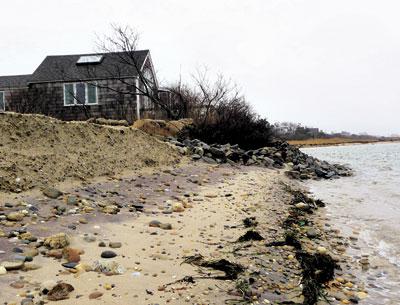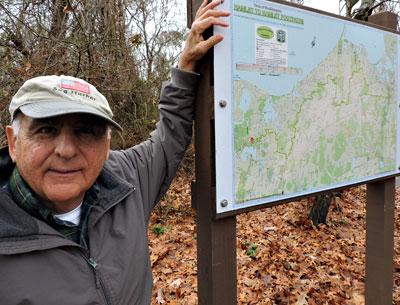Trustees Cautious on Lazy Point House Relocation
Trustees Cautious on Lazy Point House Relocation

During a Tuesday meeting, the East Hampton Town Trustees showed clear irritation at what they called pressure from residents of trustee-owned land at Lazy Point.
Susan Knobel, who wants to move her house from a shorefront lot where the beach is severely eroded to a lot at a significantly higher elevation, again asked that the trustees transfer her lease from the former location to the latter.
She read a statement detailing her efforts to save her house, saying that the meeting was the one-year anniversary of the one at which she had first brought the issue of erosion to the trustees’ attention. A surveyor agreed, she said, that the lot she seeks is the most appropriate, not only for its elevation but because her house could be moved to it with minimal disruption to the area and at a cost she is able to bear. “I’m asking you once again to please consider this,” she said.
Elaine Jones, who has spoken on her behalf at recent meetings, chided the trustees for what she said was needlessly sluggish consideration. “Everybody seems to agree, this is the property she should be able to move her house to,” she said.
The trustees took exception to that characterization. “We have to give this the proper deliberation,” Dr. Forsberg said. “For the public record, it’s not as if we’ve been sitting idle. . . . To make a rapid and a hasty decision will have repercussions. The bell cannot be unrung.”
The trustees, who have indicated their support in principle, maintain that alternative sites should be studied. Meanwhile, their concern for setting a precedent remains. When Bill Taylor, a trustee who has repeatedly expressed support for the move, cited predictions of sea-level rise, Ms. McNally made her own prediction. “I don’t think you need to wait for global warming,” she said. “All we have to do is approve one and they’ll be knocking at the door,” she added, referring to residents of Lazy Point asking to move, or raise, their houses.
The trustees will speak with the surveyor for his comments, they said, and repeated that even with their approval Ms. Knobel will need variance relief from the town’s zoning board of appeals, which is not guaranteed.
“I’m in favor of the project, Susan, but it’s not happening tonight,” said Brian Byrnes, a trustee. “A decision, I’m sure, will be rendered very soon.”



